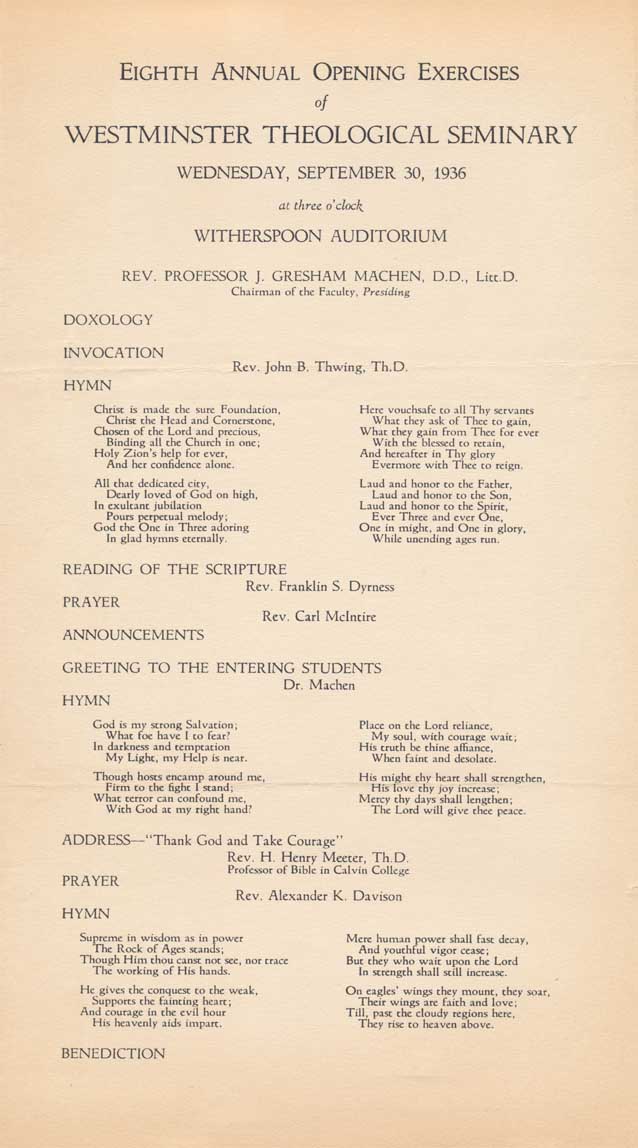Two Documents and a Digression
Today’s post is something of a modest exercise in exploring the archives, with two documents—both having the same date—drawn from two separate manuscript collections preserved at the PCA Historical Center. Nothing earth-shattering here, though there is some discovery along the way. In this case, the documents connect only in a minor way, though sometimes such connections can shed valuable light.
The first is the bulletin from the 1936 convocation service at Westminster Theological Seminary. Our copy of this bulletin is part of scrapbook no. 4 in the Henry G. Welbon Collection. The second item is a copy of a letter from J. Gresham Machen, found in the J. Oliver Buswell Manuscript Collection.
Pictured below is the service bulletin from the Eighth Annual Opening Exercises of the Westminster Theological Seminary, held on Wednesday, September 30, 1936 in Witherspoon Auditorium. This auditorium was capable of seating one thousand people, and was part of the Witherspoon Building, home of the PCUSA’s Presbyterian Board of Publications.
To digress a bit, the Witherspoon Building was named for the Rev. John Witherspoon [1723-1794], and is located at 1319-1323 Walnut Street in Philadelphia’s Market East neighborhood. It was designed by architect Joseph M. Huston [1866-1940] and the work was commissioned by the Presbyterian Board of Publications and Sabbath School Work. An eleven-story, steel frame “E”-shaped building, faced with brick and granite, the structure was built between 1895 and 1897. Exterior features include Corinthian and Ionic columns, and terra cotta decorations of statues, medallions, and seals of various boards and agencies of the Presbyterian Church as well as those of related Reformed churches. The famous sculptor Alexander Stirling Calder [1870-1945] designed six of the statues and some of the medallions that graced the building. An additional ten statues of various Biblical figures, were later cast by Samuel Murray and Thomas Eakins and installed in the exterior arches on the eighth floor. All of the statues were removed in the early 1960’s for fear of deterioration and were relocated to the courtyard of the Presbyterian Historical Society. The Witherspoon Building was added to the National Register of Historic Places in 1978.
For the commencement exercises that year, the Seminary had invited Professor H. Henry Meeter of Calvin College, His message, “Thank God and Take Courage,” was subsequently published on the pages of The Presbyterian Guardian, and can be read here (part 1), pp. 6-8 and here (part 2), pp. 27-29. [It should also be noted that The Meeter Center for Calvin Studies is named in honor of Dr. Meeter.]

A Second Document: Machen’s Advice on Deciding Moral and Ethical Conflicts
At some point on that same day, Dr. Machen set to answering some of his mail. How it was that Dr. J. Oliver Buswell, Jr. came to have a copy of this letter, is something that will have to remain a mystery. In the letter, Dr. Machen replies to an inquiry from a young woman, giving his advice on how to decide moral and ethical conflicts:
[From the J. Oliver Buswell, Jr. Papers, Box 286, File 16, file copy on green paper, 8.5” x 11”]
J. Gresham Machen
Westminster Theological Seminary
206 S. 13th St., Philadelphia, Pa
September 30, 1936
TO:
Miss Mary J. Gushard
1220 Lincoln Ave.
Prospect Park, Pa
Dear Miss Gushard:
Your letter of Sept. 24th, addressed to me at the Seminary, which I do not visit very often in vacation time, did not come into my hands until yesterday evening. In reply to your inquiry, please let me say that I do not think it to be wrong to attend the theatre. My position regarding these matters is rather c1ear, and. I have held. it for a great many years. It may be set forth in part briefly as follows:
1. It is wrong to do things that are expressly forbidden in the Bible.
2. Where things are not expressly forbidden in the Bible, the individual Christian must determine, in the light of the Bible, whether they are wrong or not, and must act accordingly.
3. It is wrong for one Christian to tyrannize over the conscience of another in these matters.
That being so, I respect very greatly the conscience of a fellow-Christian who cannot conscientiously go to the theatre. I should hate to see him do what he thinks is wrong. I certainly cannot ask him to submit his conscience to mine. On the other hand, he ought not to ask me to submit my conscience to his. With re: to the “separated” life, I should just like to say two things. In the first place, worldliness is a great danger to the Church and consecration is the thing for which we ought to strive with all our might. No mere man, since the Fall, has ever in this life been perfectly consecrated to God; but we ought to strive always to be more and. more consecrated to Him. In the second place, however, there is also an opposite danger. It is the danger of a false asceticism. It is the danger into which those persons in Colosse fell, when thoy said in a way which the Apostle rebukes: “Touch not, taste not, handle not.” We ought to strive against that danger also. Particularly ought we to avoid subjecting our fellow-Christians to rules of our own choosing that go beyond what the Word of God contains.
Such are my principles. I do not claim to have followed them perfectly. Far from it. There have been times beyond number when I have fallen short of them. certainly need to ask God daily to forgive me for my sins. But the principles that I have set forth do seem to me to be in accordance with God’s holy Word, and they are principles which I think we ought to keep before our eyes.
Very sincerely yours, (Signed) J. Gresham Machen
Image source: Henry G. Welbon Manuscript Collection, Scrapbook number 4, p. 412.
